Manaslu Circuit Trek Cost, Itinerary, Permit, Guide
The Manaslu Circuit Trek is situated above the Gorkha District’s foothills, next to Tibet’s border. It is one of Nepal’s most popular trekking routes and takes you around the Manaslu Massif (8,156m/26,758ft), the 8th highest mountain in the world.
Manaslu Circuit lies in a restricted zone, and you have to obtain a couple of permits to be allowed in. As a result, this Valley is not tainted by the mushrooming of crowds of trekkers and still retains its cultural identity.

This trek is for someone who says Nepal differently in a new way, but still offers the most stunning and astounding landscape. The hypnotic walk in Manaslu Town takes you through a relatively minor, less distant path to the beautiful wilderness, fierce white water river falls, and forests to Manaslu Mountain.
The trekking in the Manaslu region starts mostly from Soti Khola. Then, you will walk through the charming villages and terraced rice paddies, traveling in the green forests from subtropical to alpine altitudes. Larke La Pass is the highest point (5160m), and the Himalayan passes in the Manaslu region of the trek.
The trek offers marvelous views of the elevation of Mt. Manaslu (8156m), HimalChuli (7893m), Ngadi Chuli (7871m), Shringi (7187m), Larke Glacier, and the Annapurna and Lamjung Himalayan range.
Generally, it takes 14 days to complete the Manaslu Circuit Trek course. Nevertheless, Eco Nepal trekkers bring you standard 17-day itineraries. In this seventeen-day itinerary, you will have an extra day for sightseeing. Also, while returning from the summit, you will be walking from Dharapani to Besishahar instead of taking a ride.
What happens if your schedule doesn’t fit our plan perfectly? No worries! We will help you personalize your experience. In this blog, we will give you a complete Manaslu Circuit Trek Guide that you need while undertaking the Manaslu Circuit Trek.
Travel Visa
Tourists flying to Nepal can easily get an on-arrival visa at the Tribhuvan International Airport(TIA). Getting an on-arrival visa is a straightforward process. In most countries, people can get an on-arrival visa, except in a few countries. So before heading for the journey, make sure you can get the on-arrival visa or not.
The cost of the visa depends on the number of days that you will spend here in Nepal.
- For 15 Days – 30$
- For 30 Days – 50$
- For 90 Days – 125$
Note: In this Manaslu Circuit trek, you will be spending more than two weeks in Nepal, so it’s better to have a tourist visa for 30 days.
Travel Insurance for Manaslu Circuit Trek
Mountaineering is a breathtaking experience; however, it brings its own set of risks. Stuff doesn’t move according to plan, so we encourage our clients to have appropriate insurance coverage before commencing journeys with Eco Nepal Trekkers.
We advise you to purchase insurance that covers medical evacuation and travel assistance, including air evacuation. In a rare case, unexpected situations like injury, family emergencies, or work commitments can require you to cancel your trip. You can easily handle these conditions by having the right insurance policy in place.

Being covered by the right insurance gives you peace, allowing you to dedicate more time to your climbing expedition while the rest of things are taken care of.
Necessary Permit for Manaslu Circuit Trek
Multiple permits are required for the Manaslu Circuit trek as it is located in a restricted area. You can easily get the permit by filling out the forms and paying the fees. To make the journey hassle-free, Eco Nepal Trekkers will arrange the permit on your behalf.
Let’s know the permits that are required for this trek.
1. Manaslu Restricted Area Permit (MRAP)
Before starting your trek from Jagat, you need to have this permit. The cost of an MRAP permit varies depending on the season you travel.
- Cost of permit (September to November) – 100$ for the first seven days; each extra day will cost you another 15$
- Cost of permit (December to August) – 75$ for the first seven days; each extra day will cost you another 10$
2. Manaslu Conservation Area Permit (MCAP)
During the Manaslu Circuit Trek, you will be walking from Philim in the Manaslu Conservation Area. Therefore, obtaining this permit is necessary.
- Cost of MCAP for SAARC nationalities – NRs 1000 per person
- Cost of MCAP for other nationalities – NRs 3000 per person
3. Annapurna Conservation Area Permit (ACAP)
While trekking from Sama Gaon, you must have this permit as you will be walking in the Annapurna Conservation Area.
- Cost of ACAP for SAARC nationalities – NRs 1000 per person
- Cost of ACAP for other nationalities- NRs 3000 per person
Read more about the permit: Manaslu Circuit Trek Permit Information
Food and Accommodation for Manaslu Circuit Trek
On the trek to Manaslu, you won’t see any luxurious hotels. Therefore, a log cabin or a teahouse will be your home instead. A safe environment with a shared space for eating and relaxing. Before that, tea houses used to be small wooden houses that had two rooms separated by rows of timber.
Nevertheless, presently, there are some good tea houses based on modern equipment. The tea house has electricity, wifi, and hot shower facilities, but you have to pay extra bucks to get these. The quality of the wifi connection in all places is not good. Therefore, it is better to use the local SIM for mobile networks.
Dharmasala, where you must spend a night in a traveler’s inn that is designed to look like an old inn, is exactly what they built for you. In total, Dharmasala has only two guesthouses, and it has no hot showers or wifi facilities. In this place, you will be given a unique experience of realizing the most remote lifestyle of the Himalayas.
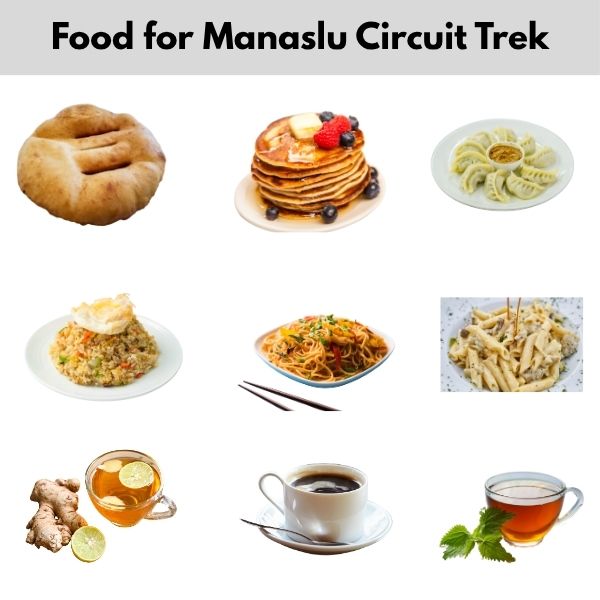
The rooms are small, yet they are clean and cozy. The rooms are set up for sharing, with 2-3 people occupying each (We provide rooms with a solo facility on special request). Here, you will be provided with a mattress, a small blanket, a pillow, and a bed cover. The add-on blanket is unavailable during peak season, and we encourage everyone to bring their sleeping bags.
The teahouse of Manaslu provides a variety of food items, although perhaps you won’t find all the things your taste buds long for. The teahouse there is getting more and more popular each day, adding more food items to its menu.
- Breakfast items: Tibetan Bread, Pancakes, Cereals, Paratha, Breakfast Set, etc.
- Lunch and Dinner items: Momo, Chowmein or Noodles, Thukpa or Thenthuk, Potato dishes, Rice with curry, Fried Rice, Pasta or Spaghetti, Pizza, etc.
- Hot Drinks: Milk or black coffee, Tibetan tea, milk tea, black tea, mint tea, ginger tea, lemon tea, or green tea. Also, you can have hot lemon with ginger, honey, and garlic soup.
- Cold drinks: Coca-Cola, Fanta, Sprite, Pepsi, canned juice, energy drinks
- Alcoholic Beverages: Local Raksi and some internationally renowned beers, whiskey, rum, and vodka.
Best Time for Manaslu Circuit Trek
Trekking to the Manaslu Circuit is possible throughout the year. However, most trekkers prefer the Spring and Autumn seasons for their Manaslu trek due to the pleasant weather and ideal temperatures.
Spring and autumn are known as the peak seasons, whereas winter and summer are known as the off-seasons. The number of trekkers is comparatively higher in Spring and autumn than in winter and summer seasons.
During Spring, the landscapes come alive with blooming flowers, lush greenery, and cascading waterfalls. In autumn, the foliage turns golden, providing breathtaking vistas of the surrounding mountains, including Manaslu, the eighth-highest peak in the world.
The ideal climbing conditions in Spring and autumn ensure climbers can ascend safely without the hindrance of harsh weather conditions. Also, trekkers will have the opportunity to witness and participate in big festivals like Dashain, Tihar, and Holi. This will help trekkers gain insight into the rich cultural heritage of the region.
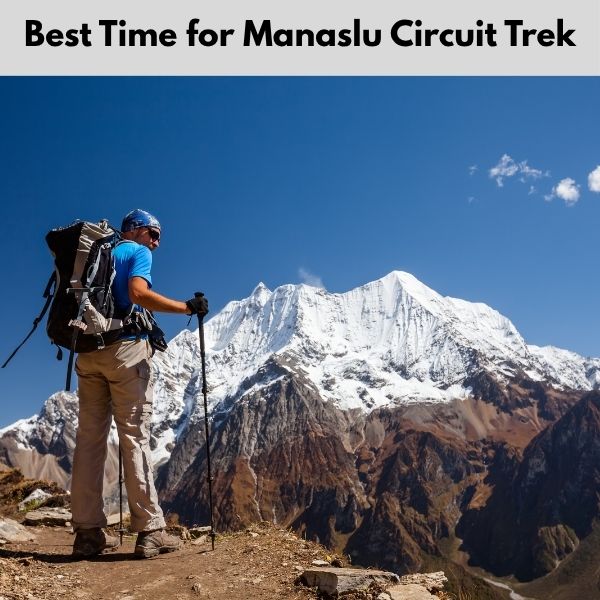
Winter in the Manaslu region, especially at high altitudes, is extremely cold. Trekkers need to pack extra clothing to deal with the temperature. The chances of getting sick are higher due to extreme cold. Also, we can expect heavy snowfall and cold wind in winter, and the chances of avalanches are higher. So, trekkers need to be extra cautious before heading for the Manaslu Circuit trek this season. This season is best if you want quiet trails and great photo opportunities.
We strictly guide against Manaslu area trekking during the summer/rainy seasons due to its inaccessibility and uncertain weather conditions. During the rainy season, heavy rains instigate landslides, floods, and avalanches that render the place dangerous. The sidewalks are wet and muddy, which is an accident-prone area for injuries. Furthermore, the nuisance presented by mosquitoes and leeches is very severe.
Manaslu Circuit Trek Difficulty
The Manaslu Circuit is a very challenging trek, especially for first-timers and those who do not have any prior training. The journey extends about 177 km from Kathmandu, which can be scary. These trails are usually 5-6 hours per day, which often include steep and rocky opportunities. This translates to covering distances of 15 to 20 km daily, which can be tiresome.
The ruggedness of the terrain is another factor that determines the level of difficulty. It provides steep uphill climbs through the hills, crags, and boulders, which makes it physically challenging. Considering that the track goes through a remote location, fewer support facilities and amenities are nearby. It is necessary to have more than the minimum physical power and time to achieve the planned trek, as haste can be problematic and risky.
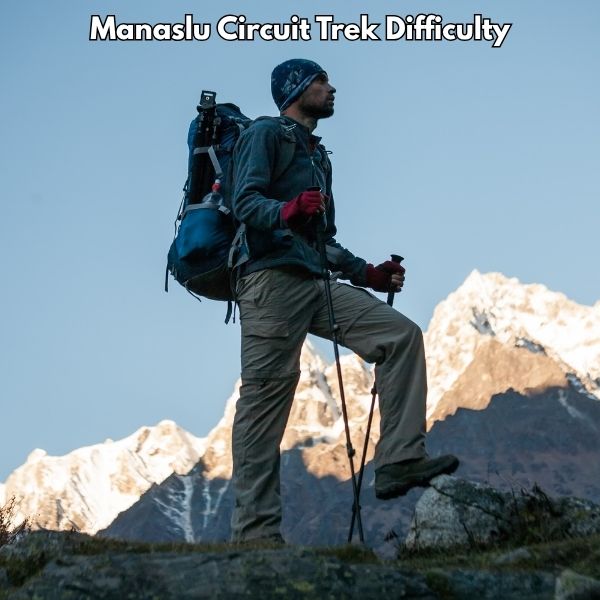
Contrary to famous treks in Nepal, Manaslu is less frequented by trekkers because of its remote position and tough trails. The accommodation and food facilities are basic here compared to other famous trekking regions.
Another major difficulty that you need to face is altitude sickness. During this trek, you will be walking above 5000m, so the chances of altitude sickness are higher. Trekkers need to be aware of altitude sickness before joining this beautiful trek.
Symptoms of Altitude Sickness (AMS)
- a headache.
- Loss of appetite.
- Feeling or being sick.
- Feeling tired.
- Dizziness.
- Difficulty sleeping.
It’s Preventive measures.
- Limit how fast you ascend.
- Take rest days to acclimate.
- Sleep at a lower altitude if possible.
- Carry preventive medications like acetazolamide or nifedipine
- Do not drink alcohol while traveling or climbing
If you’re thinking about this hike, know that it is challenging but also gratifying and worth it.
Is it possible to do a Solo Trek?
Concerning the safety of international travelers, the government of Nepal implemented new rules. The new rules state that you cannot travel solo in any restricted area. The Manaslu circuit also belongs to the restricted area in the Manaslu Region.
At the same time, heading for the Manaslu circuit trek, you need to have a special restricted area permit. To get the permit, you need to travel with the trekking agency. Also, it is mandatory to hire a Guide. Even if you hire the Guide, you need to have a group of a minimum of 2 trekkers.
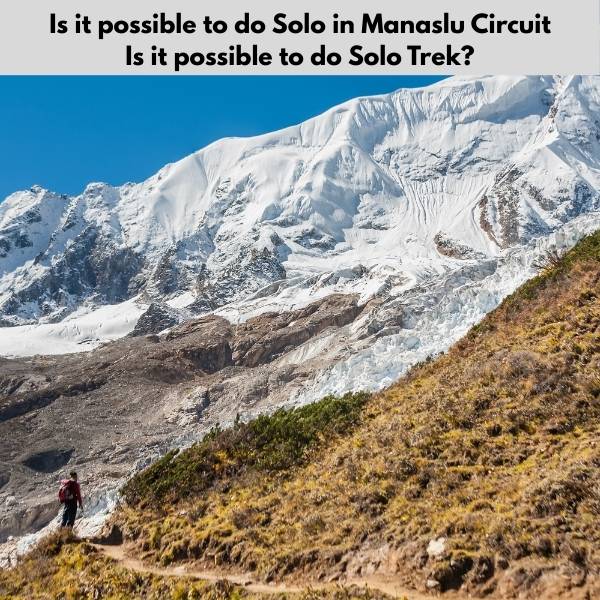
If you’re alone and want to do the Manaslu circuit trek, then don’t worry. We will help you arrange for the group to join you. Not only in the Manaslu Circuit trek, but we also suggest not trekking in any of the Everest Region, Annapurna Region, or high-altitude trekking places inside Nepal.
There are many disadvantages to doing the solo trek:
- Unaware of Altitude sickness (AMS)
- Physical exertion due to lower oxygen levels
- Navigation challenges in remote terrain
- Harsh and unpredictable weather conditions
- Isolation and limited assistance in emergencies
- Risk of injury without immediate medical aid
- Equipment failure compromising safety
- Wildlife encounters and environmental hazards
How to prepare for the Manaslu Circuit Trek?
The challenging trek around Mount Manaslu, the most remote and least traveled of the Himalayan eight-thousanders, is like walking into a fairytale. However, alongside this innocent beauty, there is an arduous march that requires both body strength and mental fortitude.
Manaslu Circuit traversing includes facing a baffling number of obstacles. They are endless altitudes, which seem to be the test of one’s endurance and the moody Himalayan weather.
From going through breathtaking landscapes to overcoming barriers of the trail, you have to stride carefully and keep paddling. Therefore, proper planning and detailed research are crucial for a successful summit.

Preparation is the name of the game and can be started with the development of prime physical fitness. Regularly performing a combination of gym workouts, yoga, and hiking all in one’s backyard helps build momentum for the easier road to come.
Adherence to daily walks of several hours spanning builds body and mind, while physical activities such as running, aerobics, cycling, and swimming improve stamina and the power of the lungs. The diversity of workouts allows for choosing what suits every person’s needs best, making the program comprehensive in its application.
However, above the physical comes the need for mental steadiness. The mind must be hardened and fortitude cultivated as obstacles face the journey. Mental preparedness is the key, which is obtained through meditation, mindfulness exercises, and visualization techniques, and helps hikers overcome any difficult situation they come across throughout their journey.
Culture and Festivals in Manaslu Region
People of Manaslu mainly practice Buddhism and Hinduism in the form of a blend of different faiths. An important practice among the Sherpas who follow Tibetan Buddhism is Buddhism. However, others, such as Gurungs and Tamangs, also have Buddhist traditions.
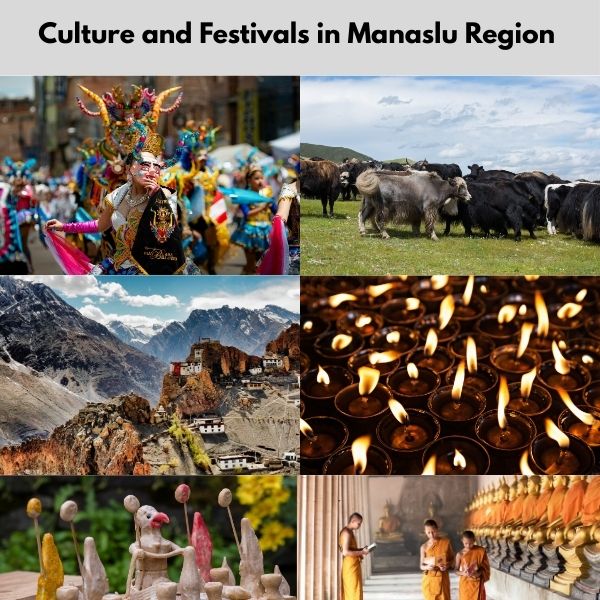
Aside from this, however, a sizable portion of the population is Hindu, and they practice their beliefs together with the Buddhist traditions, which results in a diversity of religious traditions in the Manaslu region.
Tsampa Lhosar:
The New Year’s celebrations in February and March are held with dancing parts like Lhoshars (ritual dances), spreading of cheerful music, and Khata exchange (a local scarf). Let all the hustle and bustle pass by as you get involved in each community’s New Year’s, ushering in its celebrations and prayers.
Mani Rimdu Festival:
The sacred Tsum Valley regains its glorious hues of religion during the holy month of July/ August and becomes a rainbow of devotion. Notice the breathtaking Thangkas (representative tapestry) that hang on the top of a hill. They are the brightest illustrations of Buddha’s teachings and folklore. Be completely involved in the dancing as the spiritual energy of the festival is reviving you.
Tiji Festival:
September and October are the Tiji Festival seasons. It is a life-blooming festivity that takes place in the Mustang region in the form of a Tibetan Buddhism celebration. Get to know the Chaam dance, a mesmerizing dance in which monks who wear colorful costumes act out the heroic battles of gods and demons. This event leaves such an unforgettable impression due to the colorful costumes, emotional music, and multi-layered symbolism.
Yak Herding Festival:
In the middle of November or December, the public focuses on a tribe of huge and strikingly beautiful yaks, which serve as the basis of the local economy. Go to the Yak Herding Festival, a sumptuous event held to honor the cunning and good-natured giants. See yak races and shearing matches, and sing along to the popular lyrics that cherish the connection between human existence and these amazing animals.
Chyangba Festival:
White Winter coats the fields. It is time for the warm December Chyangba Festival, which brings people together to celebrate life and the community. Join in local Traditional archery events. You will get a chance to watch snow yak races go on. Also, you can enjoy the bonfire, which will help warm you up under the beautiful night skies.
Gompas & Monastery
In the Manaslu region, the numerous Buddhist monasteries rich in spirituality, beautiful architecture, and cultural legacy are undoubtedly there, which attract pilgrims for this coveted reason.
Some of the famous Buddhist monasteries in the Manaslu region include:
- Rachen Gompa
- Mu Gompa
- Sama Gompa
- Samdo Monastery
- Pungyen Gompa
Transportation Options During the Manaslu Circuit Trek
The journey for the Manaslu Circuit Trek is an off-beat path. You will have two options: take a local bus or hire a private jeep. The initial road condition is good; later, you will drive through dirty and bumpy roads in some parts.
To reach the starting point of the Manaslu Circuit Trek:
- Journey on Local Bus: 20$ per person
- Journey on a Private Jeep or car: 250$ per person
Returning option after completing Manaslu Circuit Trek:
- Dharapani to Besishahar private Jeep costs: 180$ per person
- Besisahar to Kathmandu Private Car costs: 190$ per person
- Besisahar to Kathmandu private Jeep costs: 280$ per person
- Besisahar to Kathmandu Local Bus costs: 25$ per person
Note: This price may vary depending on the season and the availability.
Related article
- Kathmandu to Pokhara Travel Guide
- An Essential Guide to the Annapurna Base Camp Trek Permit
- Everest Base Camp Trek for Beginners: A Complete Guide
- Beginner’s Guide For The Annapurna Base Camp
Frequently Asked Questions
Where is the Manaslu Circuit trek located?
Manaslu circuit trek lies between the Gorkha and Manang districts and is located in the northern part of Nepal, 64 kilometers from Annapurna.
What is the Manaslu Circuit trek famous for?
The eighth-highest peak in the world, called “Kutang,” is Mount Manaslu. Besides the Manaslu Circuit Trek, trekkers are frequently rewarded with amazing views of prominent mountains like Himalchuli, Ngadi Chuli, Manaslu, Annapurna, Shringi, Ganesh Himal, and others. These unique vistas are part of the success of the Manaslu Circuit trekking route.
How safe is it to drink natural water?
Streams and rivers by the Manaslu Circuit Trek can also look crystal clear, yet they still may contain bacteria and parasites. So, the water should be treated or purified before drinking to avoid waterborne problems. Hikers often treat water by using water purification tablets and filters or even boiling the water to make it safe for drinking. Planning and carrying adequate water treatment equipment with you along the trip is crucial for ensuring safe drinking water.
Do you need to carry oxygen for the Manaslu Circuit Trek?
No. Naturally, we don’t have to carry oxygen for the Manaslu Circuit trek because our itinerary is set up in such a way that it gives us the required acclimatization at every stop. Besides, adequate Diamox (a drug that suppresses the symptoms) will be supplied from the outset, and even before falling sick. On the other hand, if the symptoms worsen, immediate emergency medical evacuation will be done.
Is it possible to make a Manaslu circuit trek by Helicopter?
Yes, you can take a private helicopter tour for a day to see Mt. Manaslu up close. It’s great for folks who can’t do long treks but still want to witness the stunning views of this majestic mountain.
Can I return to Kathmandu by Helicopter from Manaslu Base Camp?
Yes, you can combine the Manaslu circuit trek with a helicopter return from the base of the Larke La pass, 5,106 m.
Here is the itinerary outline for this package.
- Day 01: Arrival in Kathmandu
- Day 02: Helicopter flight to Jagat (1410m) and trek to Philim (1570m), 3hrs
- Day 03: Trek to Dyang (1800m), 6hrs
- Day 04: Trek to Namrung (2630m), 6hrs
- Day 05: Trek to Syala
- Day 06: Trek to Sama Gaun (3530m), 5hrs
- Day 07: Sama Gaun for acclimatization and visit to Manaslu base camp(4800m)
- Day 08: Trek to Samdo(3860m), 5hrs
- Day 09: Trek to Dharamsala / Larke phedi(4460m), 5hrs
- Day 10: Cross Larke La(5106m) and to Bimtang (3720m), 8hrs
- Day 11: Chartered helicopter flight back to Kathmandu
- Day 12: Departure
What are the starting and ending points of the Manaslu Circuit trek? Total distance covered?
The Manaslu Circuit trek starts in Besisahar and ends in Dharapani. Along the road they travel, the trekkers cover an approximate distance of 177 kilometers.
Conclusion
The Manaslu Circuit trek is an enjoyable trip to fascinating mountains and villages. It’s more than walking; it’s about experiencing different cultures and meeting nice people. The memories you treasure on this hike will accompany you throughout your life, always reminding you of the incredible adventure you had in the Himalayas.

